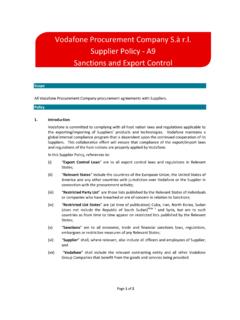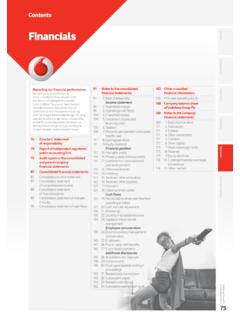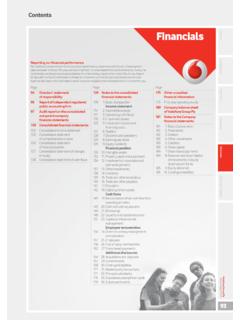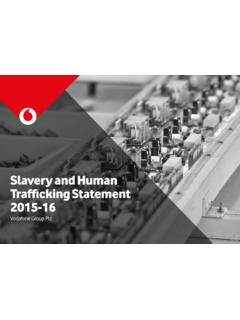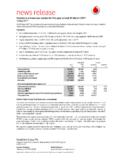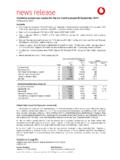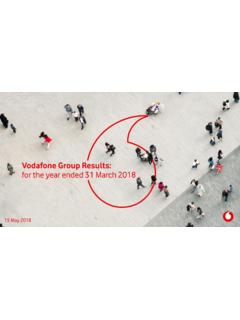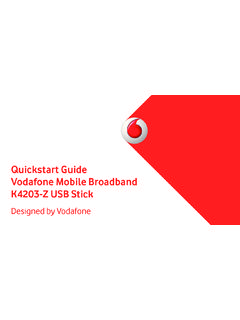Transcription of Women’s Empowerment - Vodafone
1 Increasing diversityOur ambition is for Vodafone to become the world s best employer for women by 2025 Gender balance26% of our senior leadership team and 30% of our Vodafone Group Board are women Connecting womenWe aim to connect an additional 50 million women living in emerging marketsWomen s EmpowermentEquality of opportunity between men and women is a key indicator of long-term social stability and economic advancement. By empowering women and promoting gender equality we can enable communities, economies and businesses including our own to Group Plc Sustainable Business Report 20176 Sustainable Business Report 2017 Vodafone Group Plc7 Equality of opportunity between men and women is a key indicator of long-term social stability and economic prosperity.
2 Over the last two decades, there has been significant progress in closing the global gender gap, particularly in areas such as education and health. However, major challenges remain. Relative female economic disadvantage is a common characteristic across cultures and societies. One study estimates that at current rates of progress in closing the gender gap in the workplace, women will not reach parity with men in terms of pay and employment opportunities for another 170 years1. An estimated 54% of working-age women worldwide are active within the formal economy (as opposed to the black or grey economy) compared with 81% of men. The comparative lack of women in senior, better-paid roles means that the global average for women s earnings is around half that for men.
3 There are also indications that this differential has expanded in recent gender gap is greatest within patriarchal cultures in emerging markets; however, there are also systemic inequalities within even the most advanced economies. Women and men enter the workplace as young adults with equivalent skills and in broadly equal numbers; however, as their careers evolve, a much greater proportion of men than women enter middle and senior-level roles. A significant proportion of women either leave the formal workforce altogether or remain within it but in more junior roles than their male peers. This leaky pipeline of female talent is evident worldwide; only four out of more than 190 countries have equal numbers of male and female legislators, senior officials and managers3.
4 Maternity represents a significant inflection point for many women. A lack of support through pregnancy and childbirth and the challenge of balancing childcare with working life accounts for the departure of large numbers of women from the workplace. Women often experience difficulties in rejoining the workforce after taking a career break to bring up children or support their family. Others may return to work but find fewer opportunities for promotion and progression than their male counterparts4. This is a lost opportunity. A new study from KPMG indicates that, at a global level, if more skilled women on a career break were encouraged and able to re-enter the workplace (and on the assumption that they would not displace others in doing so), the maximum potential boost to economic activity worldwide would be around 103 billion, with the potential addition to total household earnings in the region of 290 billion5.
5 In emerging markets, the gender gap tends to arise earlier in life. An estimated 130 million girls around the world are currently out of school and are more likely to remain excluded from education than boys6. Evidence suggests that women in emerging markets are more likely to live in poverty than men7, and it is estimated that every day approximately 830 women die from preventable causes related to pregnancy and childbirth8. The United Nations Sustainable Development Goals recognise that gender equality is core to the effective functioning of modern society. It is estimated that measures to enable women and girls to thrive alongside men and boys could improve public health, increase productivity and grow prosperity, adding US$12 trillion to global GDP by and women s empowermentWe employ more than 108,000 people and are one of the largest foreign investors in many of the countries in which we operate.
6 We also provide employment opportunities for hundreds of thousands of people across our global supplier base of more than 17,000 companies. We have a strong commitment to diversity and women s Empowerment within our own business and believe that achieving greater gender parity will strengthen our company significantly over time. We have therefore identified Women s Empowerment as one of our three core global transformation technology can play a critical role in women s Empowerment . Even a basic mobile provides a woman with the freedom to communicate, ask for help, learn, set up and run a business and as we explain later in this Report achieve financial security. Mobile technologies also enhance a wide range of public services and economic activities of direct relevance to women and girls in emerging markets: from vaccinations and maternal healthcare to increased crop yields for smallholder farmers and mobile banking financial services for self-employed homeworkers.
7 Women s Empowerment The global context4 out of 190countries have equal numbers of male and female legislators, senior officials and managersVodafone Group Plc Sustainable Business Report 2017 Introduction | Women s Empowerment | Energy Innovation | Youth Skills and Jobs | Principles and Practice | Supply Chain Integrity and Safety | Mobiles, Masts and Health | Appendix8 Our emerging markets serve more than 320 million active10 mobile customers, an estimated 110 million of whom are women. We have already developed many mobile technologies that are changing women s lives (as we explain later in this section) and have set ourselves the goal of bringing the benefits of mobile to an additional 50 million women living in emerging markets, including women in some of the world s poorest is estimated that more than billion women in low and middle-income countries do not own a mobile phone11.
8 Worldwide, women are 14% less likely to own a mobile than men. This equates to a mobile gender gap of approximately 200 million women who are unable to use a mobile to manage their daily lives and seek opportunities to grow and learn. Some of the reasons for this are economic; however, many are linked to cultural norms. Closing the mobile gender gap would have a positive socio-economic impact for women and society as a whole. It also represents a commercial opportunity. It is estimated that connecting more women (and increasing the mobile usage of existing women customers) to reach parity with men could enhance industry revenues by around US$170 billion from 2015 to 202012. There is therefore a very strong alignment between a critical societal need and a global industry commercial opportunity.
9 Our commitment to women s Empowerment begins at the top of the company. Vodafone s diversity and gender equality activities are overseen by the Vodafone Group Board and are led directly by our Group Chief Executive, who is one of 10 global chief executives acting as champions for the UN Women s global solidarity movement for gender equality, aspiration is to be the world s best employer for womenWe seek to be a company whose global workforce reflects the customers we serve and the broader societies within which we operate. We believe our strong commitment to diversity is a source of business strength, enabling us to understand better the needs of the men and women, families and businesses who rely on our networks and need for gender equality in the workplace has been recognised for decades with an increasing number of statutory obligations in developed countries.
10 However, women remain under-represented in many workplaces (and strikingly so at the most senior levels). Our long-term ambition is to become an employer whose track record in attracting and retaining female talent is so strong that we are widely considered to be the world s best employer for women by 2025. By demonstrating leadership as a beacon employer in each of the countries in which we operate, we believe other companies will seek to emulate our approach, thereby further expanding the range of opportunities for women across the broader working world. Shortly after the period under review, Vodafone was recognised as one of The Times Top 50 Employers for Women a list compiled together with the UK not-for-profit organisation Business in the such as our ground-breaking global maternity policy and our ReConnect initiative to bring women back into the workforce after a career break are designed to address the challenge of the leaky pipeline (explained earlier) and maximise our ability to recruit, retain and develop women at every level of our workforce.
